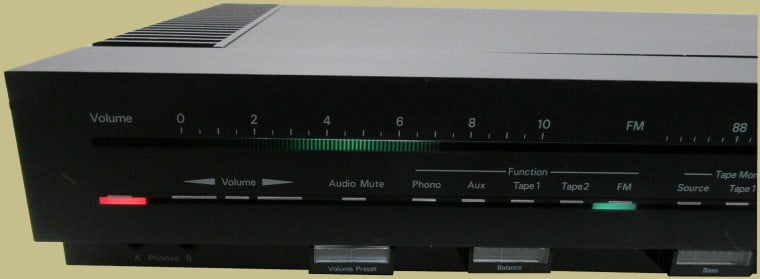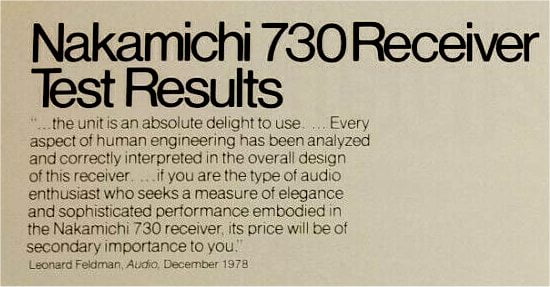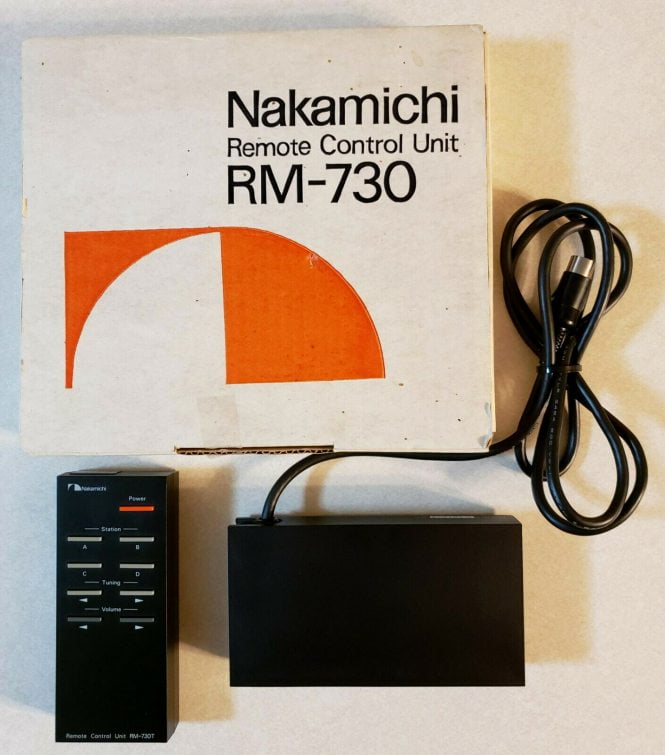
This Nakamichi 730 came out at the beginning of the transition period when audio manufacturers were moving from silver faced analog equipment housed in wood cabinets to black metal cased, LED lit, computer run equipment. This may not have been everyone’s top choice for most beautiful receiver but it was definitely ahead of its time and performed like a champion. The 730 retailed for a whopping $1390 and production ended around 1982.

Introduced in 1978 the Nakamichi 730 produces 105 watts per channel into 8 ohms. It’s no lightweight stereo. Its 38 pounds are fit snugly into a slim case that measures about 20″ wide, 15″ deep, and only 3.75″ tall. There are no mechanical buttons on the 730. All the of the switches on the front panel are touch sensitive. With the matte black case and red and green lighting it’s a very high tech looking piece of transitional era equipment.
The narrow slot along the entire length of the top half of the receiver houses the illuminated green stripe volume filter and the linear calibrated FM dial scale. It also has four station presets, Dolby FM, Muting and a High Blend function. The high blend control blends stereo with mono. It is able to reduce hiss on weak signals by utilizing most of the signal in stereo with the exception of the higher frequencies which are mono. The controls just below the station preset sensors are fine tuning controls for each preset station.

The four sliders along the bottom are a pre-set volume contour control, Bass and Treble controls and an FM muting threshold control. The volume contour control adjusts the sensitivity of the main volume control. There are also two stereo headphone jacks at the bottom left of the receiver (yes, two!).
The volume control is motorized as is the FM tuner. Touch the tuning sensor and a small motor turns the tuning capacitor. While other manufacturers were moving toward FM tuners with no moving parts, Nakamichi concluded that the old way was better and used a conventional tuning capacitor but modernized it with the touch sensitive control and motorized movement. Strangely the 730 has an AM/FM tuning gang inside even though it is an FM only receiver. The designers actually use the AM capacitance to tell the built in logic circuit when the main FM tuning section has reached the exact preset station. So, they basically use the AM tuner to tell the circuit when the FM tuning is precisely located at one of the four preset stations. Ingenious.

Specifications:
- Tuning range: FM
- Power output: 105 watts per channel into 8Ω (stereo)
- Frequency response: 10Hz to 30kHz
- Total harmonic distortion: 0.02%
- Damping factor: 100
- Input sensitivity: 2mV (MM), 100mV (line)
- Signal to noise ratio: 83dB (MM), 94dB (line)
- Channel separation: 70dB (MM), 70dB (line)
- Output: 100mV (line), 1V (Pre out)
- Dimensions: 500 x 90 x 370mm
- Weight: 17.2kg
- Year: 1978

The Nakamichi 730 was sold with a wireless remote control unit, the RM-730.
Working on the 730 is not for the faint of heart. There are no visible fasteners on the front, side or top panels. Instead there is a plug on the rear left of the unit. Remove the plug and you’ll see a screw. Turn the screw and the side panel will release. Then you will find the screws to the top panel.
Look at that transformer and the two huge 63V 15,000 mF power supply caps! As you can see, the power supply section is shielded. Overall great build quality, but not easy to work on.

Some issues related to the 730 are that the slider pots can get dirty and the bulbs tend to burn out. By removing the front panel you can access all the bulbs. The original bulbs are 12v 3mm 60mA. Many times the remote is missing as well and they are not cheap to replace. However some of the newer universal remotes may work.
The knob on the back just above the jumpers controls the record-out levels when recording to a tape deck. There is also a master power on/off switch and a couple AC receptacles. The master power switch is usually left on so that the remote control box can supply power to rest of the stereo. The receiver also has pre-out/main-in jacks, so you can separate the preamp from the power amp. As you can see the 730 will only accommodate one pair of speakers.

The Nakamichi 730 is a great receiver. If you like the its style and can find one in good working order, especially with the original remote, then you should acquire it. You won’t be disappointed.
I think that a serviced 730 should have LEDs in place of the miniature lamps (in particular the tuning indicator which gets hot and oxidises the flexible polyimide PCB).
In 2019 I repaired and overhauled a 730. The faults were 50% logic and faulty soldering, the other 50% were mechanical items such as jammed volume control, broken plastic tabs on the front panel backlight, and no screw fastenings to marry the selection PCBs to the front panel. Thankfully nothing was wrong with the tuner.
Also, anyone fixing a 730 had better realise that the mute circuit kills the input if a lamp has failed! Removing D311 stops the lamp fail mute!!
A lot of work, but a beautiful result.
who can fix mine?
I have a guy in Chicago. Warranted work 1 year.
Got his name / contact?
Howard Russell
Overland Park, KS
312-351-2008
Thanks for posting your experience working on one of these. I inherited one and the volume appears to be stuck as well. Also, not really knowing how to set it up, I’m finding that neither the phono nor the aux inputs are giving much signal if at all. But when I plugged my tablet into the “mains” I suddenly got wonderful sound. From what I understand this somehow bypasses the preamp? I’m assuming this is why the bass and the treble don’t work. Anyway, I do not possess the remote. I will attempt to remove the cover so I can see if there’s anything I can do to fix the stuck volume but any advice in this regard would be super helpful. Thanks!